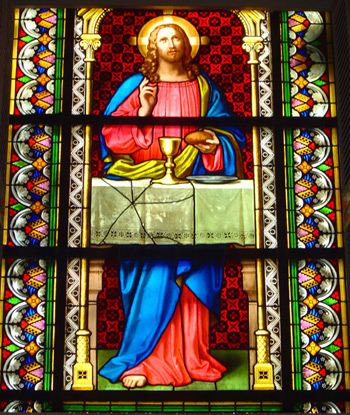Mystery of The Shuttered Window
At the head of the chancel of King’s Chapel is a Palladian window – a large, shuttered window. What lies behind the cover? Why is it covered?
The shuttered window is symbolic of the fascinating evolution of King’s Chapel. Founded in 1686 as the first Anglican Church in New England, it emerged from the American Revolution as America’s first Unitarian Church.
The Journey – from Anglican to Unitarian
A part of the Church of England, the congregation of the original Anglican King’s Chapel was comprised of royal officials, English military officers, and many of colonial Boston’ s leading merchant families. The church was perceived by the overwhelming Puritan Congregationalist community as a church of the rich with allegiance to the Crown.
Following the American Revolution, the congregations of Anglican churches throughout the colonies dwindled in size. At King’s Chapel, the Englishmen in the King’s service, officials and military officers, returned home. American merchants who had familial and economic ties to England found themselves political outsiders. They left too. With this exodus, the vast majority of Anglican churches had two options – buy-in to the centrally-controlled hierarchy inherent in the church and hold on to the remaining committed Anglicans, or become a community church.
The Third Option – The arrival of James Freeman
Luckily, King’s Chapel thought of a third option – hire out lecturers from Harvard Divinity School until a solid plan could be established. In 1785, a young Unitarian named James Freeman became the chief lecturer at the new King’s Chapel, which, in keeping with the sentiment of the time, was no longer named for King James II, but for Christ the King.
The parishioners liked his lectures and sermons so much, that they ordained him later that year as minister, making King’s Chapel the first Unitarian Church in America. Notably, Freeman’s Unitarian faith deviated from most American Unitarian churches. King’s Chapel was unique: Unitarian in theology; Congregational in governance; Anglican in liturgy.
Freeman appreciated the beauty and power of the Anglican rites so much, he kept parts of it – yes, parts of it. He took pieces of paper, glue, and an ink pen and proceeded to white out anything in the Book of Common Prayer that was not agreeable to the Unitarian faith! This version of the Book of Common Prayer is still used by the congregation of King’s Chapel today.
 And now …The Window!
The stained glass window behind the shutters depicts Christ at the Last Supper. Along with two flanking windows of St. Paul and St. Peter, it was installed in 1863, a time of a religious revival. However, by 1936, the more modern Unitarianism believed the window themes were too dominating. The two saints were removed; the center, Christ window, was covered.
Easter Revelation
Once a year, the lovely stained-glass window is revealed. On the evening before Easter, appropriately during the solemn Easter Vigil, the window of Christ at the Last Supper is ceremoniously uncovered – just for 24 hours.
And now …The Window!
The stained glass window behind the shutters depicts Christ at the Last Supper. Along with two flanking windows of St. Paul and St. Peter, it was installed in 1863, a time of a religious revival. However, by 1936, the more modern Unitarianism believed the window themes were too dominating. The two saints were removed; the center, Christ window, was covered.
Easter Revelation
Once a year, the lovely stained-glass window is revealed. On the evening before Easter, appropriately during the solemn Easter Vigil, the window of Christ at the Last Supper is ceremoniously uncovered – just for 24 hours.
 And now …The Window!
The stained glass window behind the shutters depicts Christ at the Last Supper. Along with two flanking windows of St. Paul and St. Peter, it was installed in 1863, a time of a religious revival. However, by 1936, the more modern Unitarianism believed the window themes were too dominating. The two saints were removed; the center, Christ window, was covered.
Easter Revelation
Once a year, the lovely stained-glass window is revealed. On the evening before Easter, appropriately during the solemn Easter Vigil, the window of Christ at the Last Supper is ceremoniously uncovered – just for 24 hours.
And now …The Window!
The stained glass window behind the shutters depicts Christ at the Last Supper. Along with two flanking windows of St. Paul and St. Peter, it was installed in 1863, a time of a religious revival. However, by 1936, the more modern Unitarianism believed the window themes were too dominating. The two saints were removed; the center, Christ window, was covered.
Easter Revelation
Once a year, the lovely stained-glass window is revealed. On the evening before Easter, appropriately during the solemn Easter Vigil, the window of Christ at the Last Supper is ceremoniously uncovered – just for 24 hours.